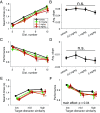M1-selective muscarinic allosteric modulation enhances cognitive flexibility and effective salience in nonhuman primates
- PMID: 37104474
- PMCID: PMC10161096
- DOI: 10.1073/pnas.2216792120
M1-selective muscarinic allosteric modulation enhances cognitive flexibility and effective salience in nonhuman primates
Abstract
Acetylcholine (ACh) in cortical neural circuits mediates how selective attention is sustained in the presence of distractors and how flexible cognition adjusts to changing task demands. The cognitive domains of attention and cognitive flexibility might be differentially supported by the M1 muscarinic acetylcholine receptor (mAChR) subtype. Understanding how M1 mAChR mechanisms support these cognitive subdomains is of highest importance for advancing novel drug treatments for conditions with altered attention and reduced cognitive control including Alzheimer's disease or schizophrenia. Here, we tested this question by assessing how the subtype-selective M1 mAChR positive allosteric modulator (PAM) VU0453595 affects visual search and flexible reward learning in nonhuman primates. We found that allosteric potentiation of M1 mAChRs enhanced flexible learning performance by improving extradimensional set shifting, reducing latent inhibition from previously experienced distractors and reducing response perseveration in the absence of adverse side effects. These procognitive effects occurred in the absence of apparent changes of attentional performance during visual search. In contrast, nonselective ACh modulation using the acetylcholinesterase inhibitor (AChEI) donepezil improved attention during visual search at doses that did not alter cognitive flexibility and that already triggered gastrointestinal cholinergic side effects. These findings illustrate that M1 mAChR positive allosteric modulation enhances cognitive flexibility without affecting attentional filtering of distraction, consistent with M1 activity boosting the effective salience of relevant over irrelevant objects specifically during learning. These results suggest that M1 PAMs are versatile compounds for enhancing cognitive flexibility in disorders spanning schizophrenia and Alzheimer's diseases.
Keywords: acetylcholine; attention; cognitive control; donepezil; learning.
Conflict of interest statement
The authors declare no competing interest.
Figures




References
Publication types
MeSH terms
Substances
Grants and funding
LinkOut - more resources
Full Text Sources
Medical
Miscellaneous

